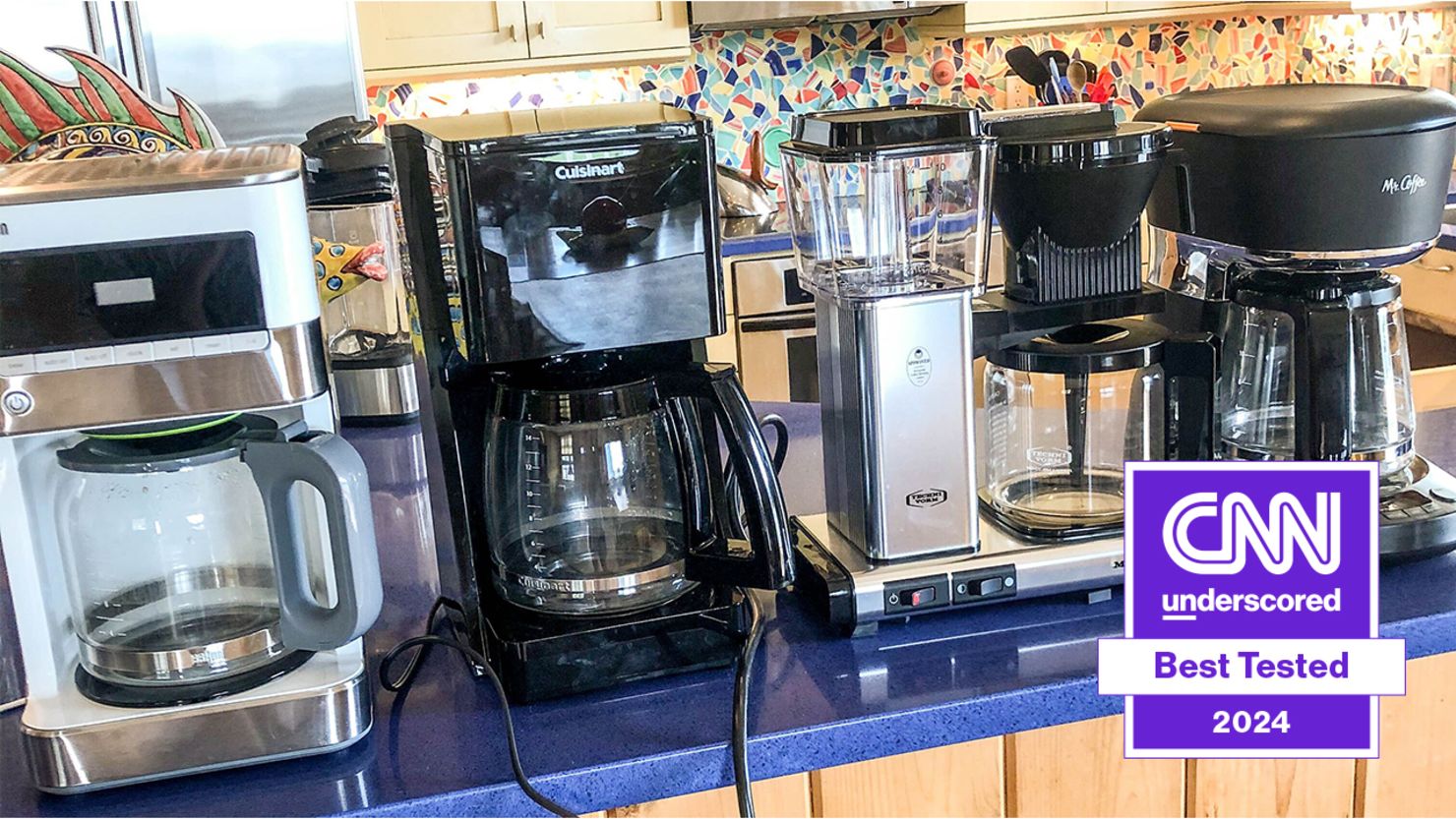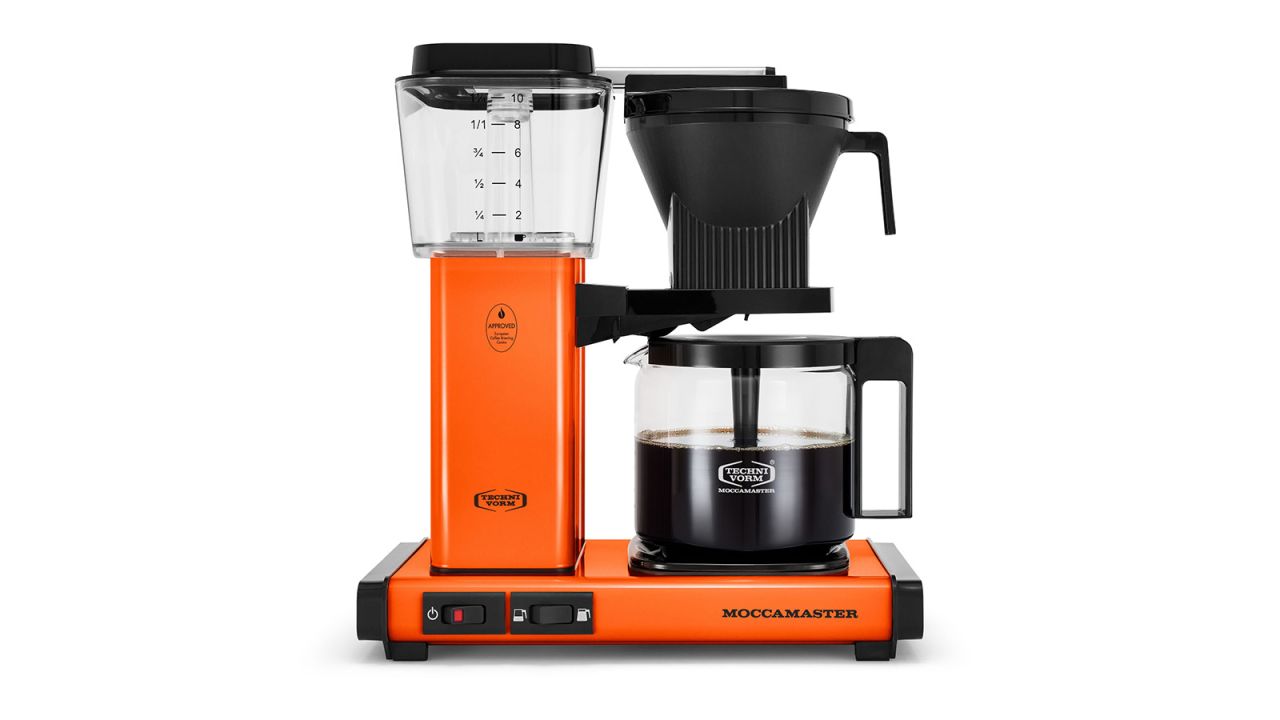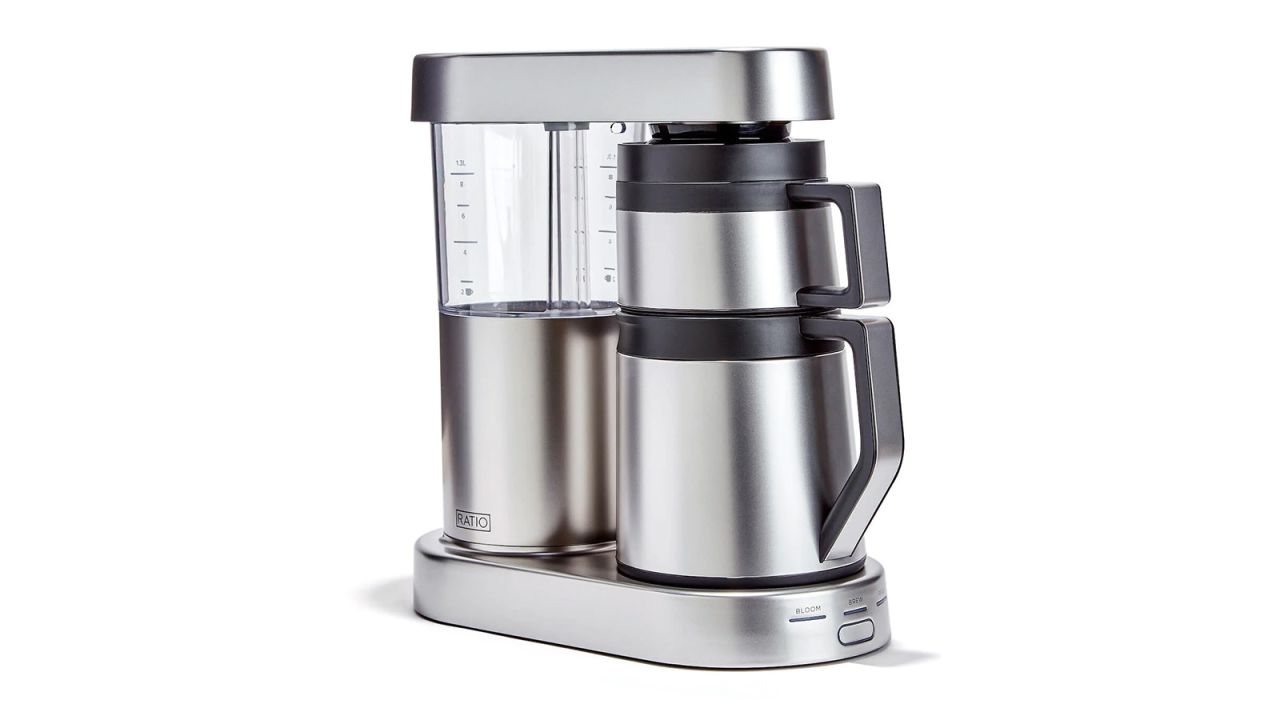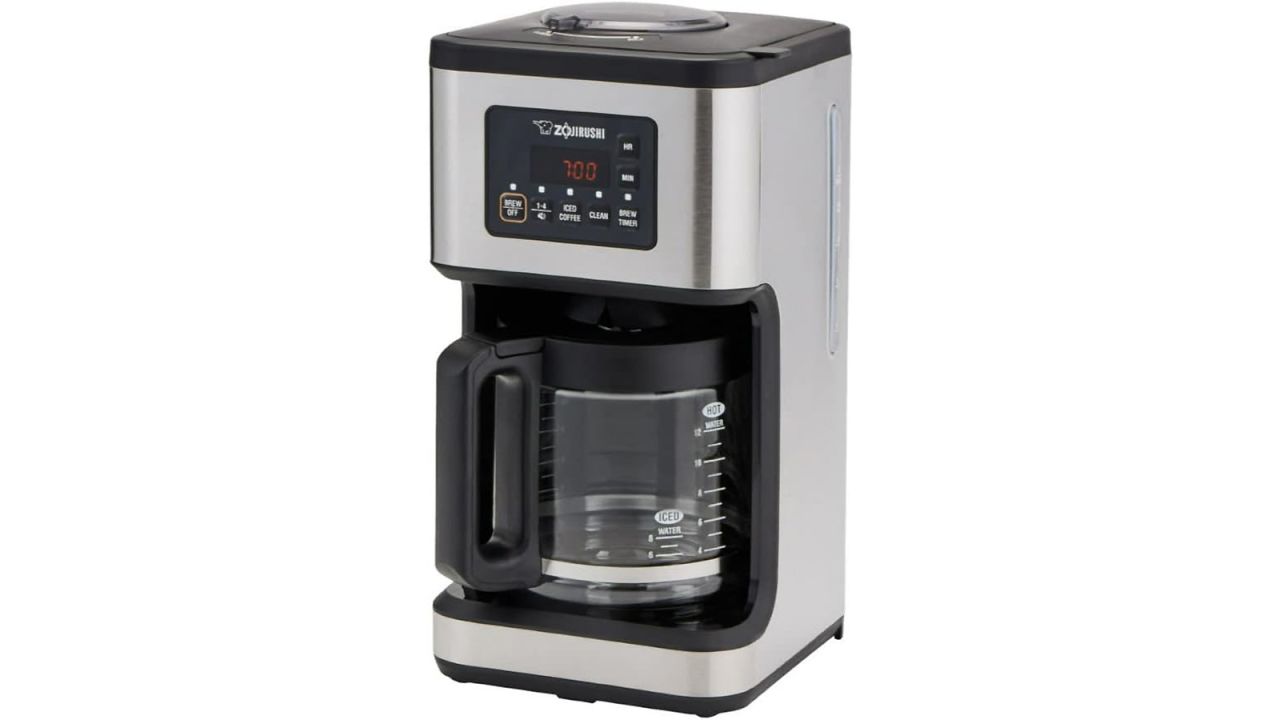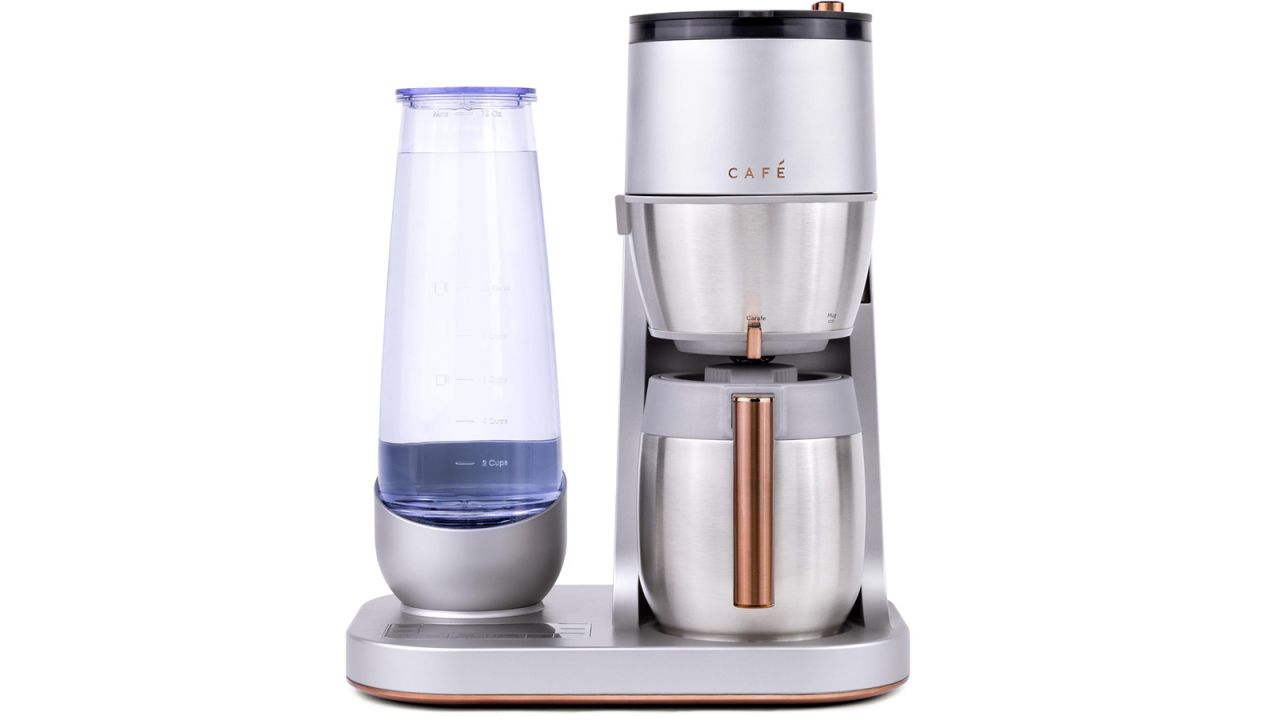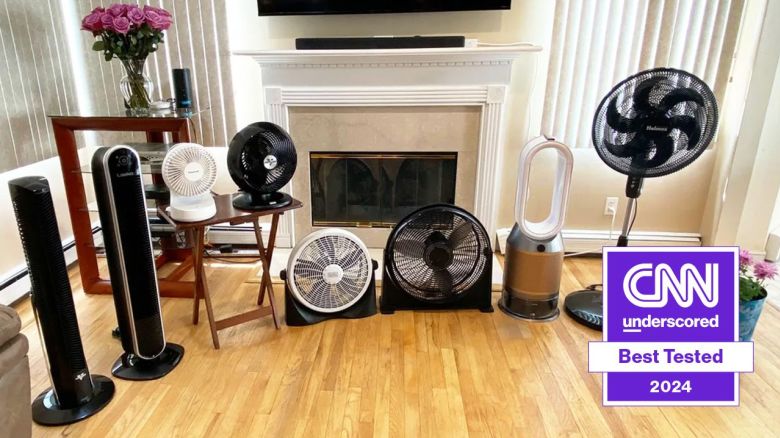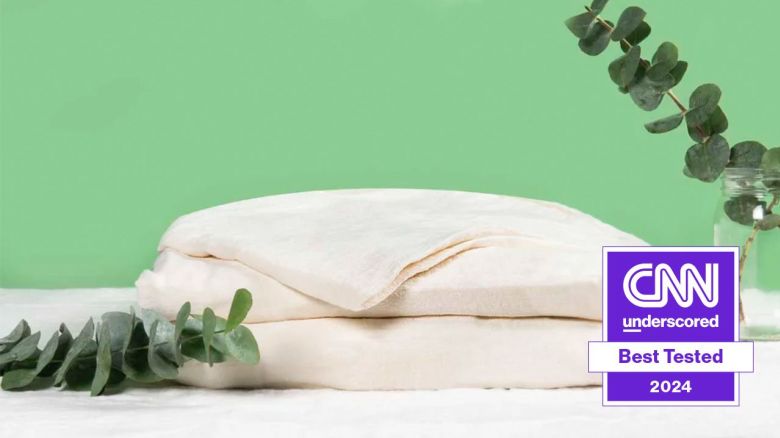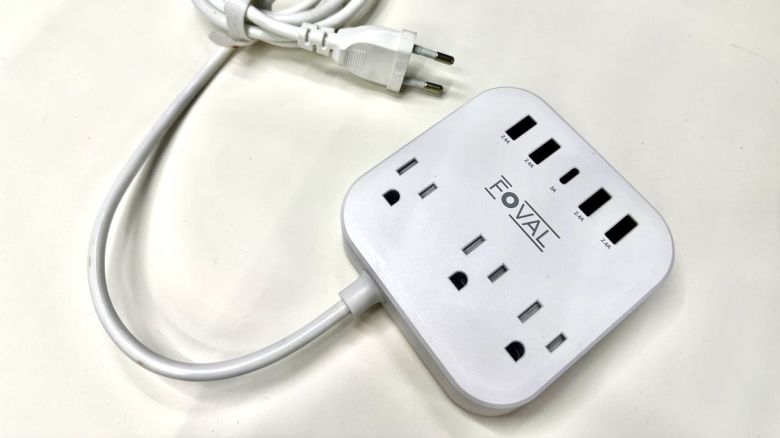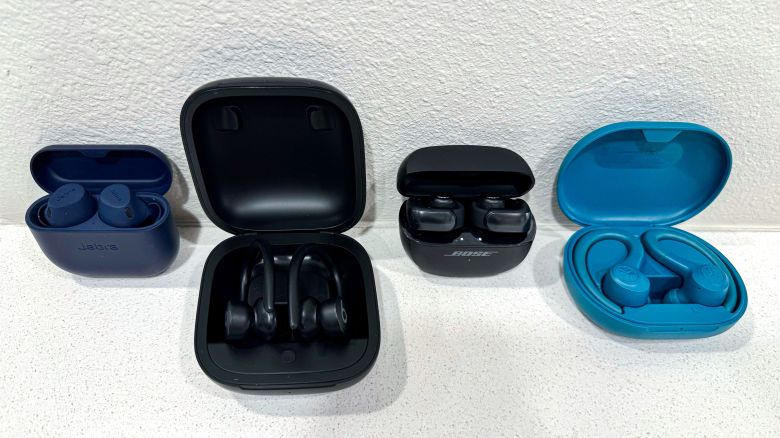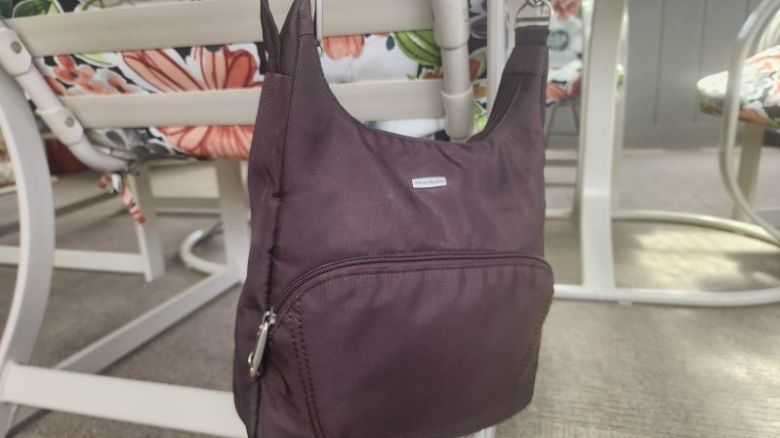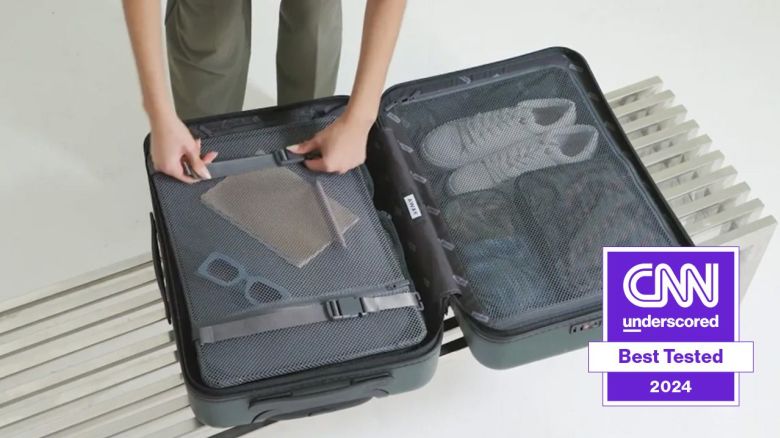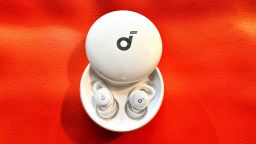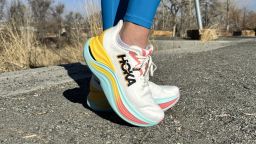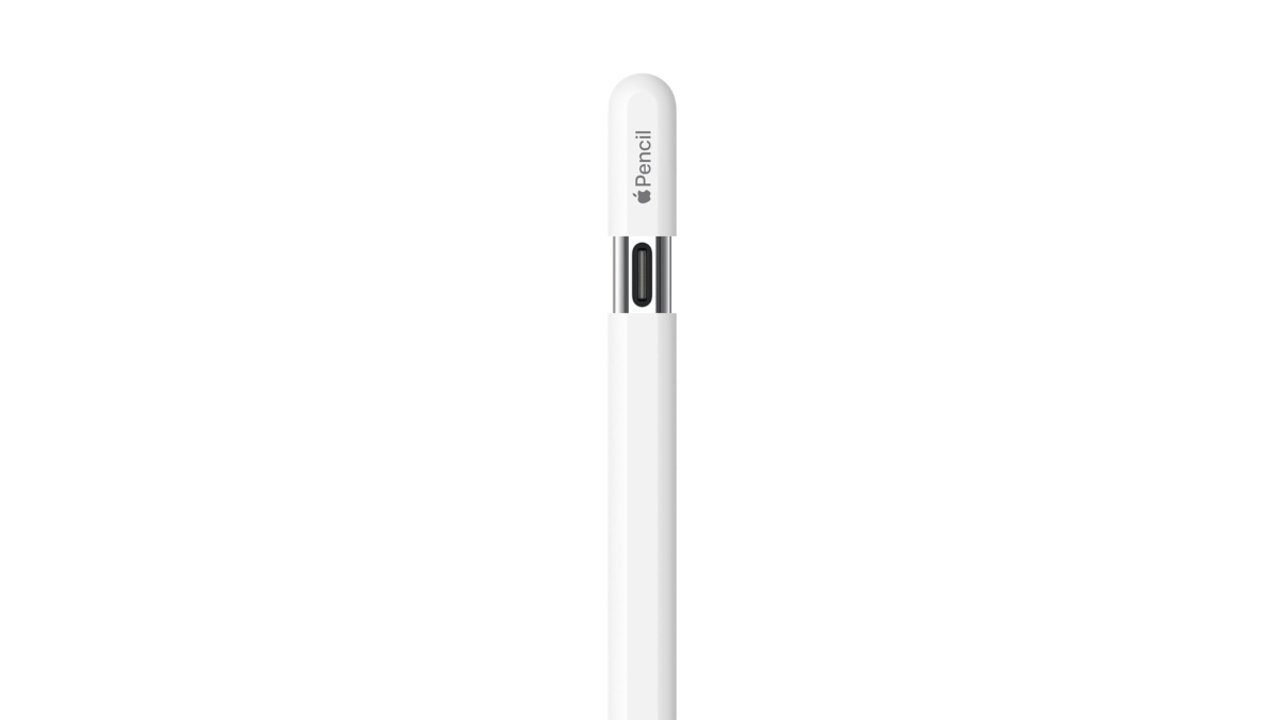There are so many brewing methods to choose from (French press, dalgona whipped, pour-over), but many coffee lovers still rely on the classic, automatic drip for their daily fix. That’s why we tested the best-rated drip coffee makers using a wide range of criteria (outlined below) over the course of several weeks. Bags upon bags of dark roast, light roast and medium roast coffee beans were ground and brewed. We made full carafes, half carafes and single serve cups. And we tasted the results black, with cow’s milk, almond milk, sweetened condensed milk, cold-brew strength over ice — you name it.
After testing a multitude of machines over the past few years, we’ve got plenty of great drip coffee maker recommendations for you, whatever your coffee taste and budget.
The Braun BrewSense Drip Coffee Maker produced consistently delicious, hot cups of coffee, brewed efficiently and cleanly, from sleek, relatively compact hardware that is turnkey to operate, and all for a reasonable price.
An upgrade to an old favorite, the Technivorm Moccamaster KBGV Coffee Brewer can turn out a half or full carafe of perfectly brewed coffee, and the process is just as entrancing to watch.
The Ratio Six Coffee Maker automates the pour over coffee process, producing rounded, flavorful coffee without the fuss of keeping track of temperature and pouring rate. It's great for newcomers to the style.
The Zojirushi Dome is among the slowest brewing machines we tested, but it produces strong hot brews and delicate, flavorful iced coffee.
A built-in burr grinder; the ability to brew anything from a cup to a full carafe of bold, bright coffee; and a well-designed, actually useful app make the Cafe Specialty a great choice if you like to geek out on your morning cup.
Best drip coffee maker overall: Braun BrewSense Drip Coffee Maker
$129 at Amazon
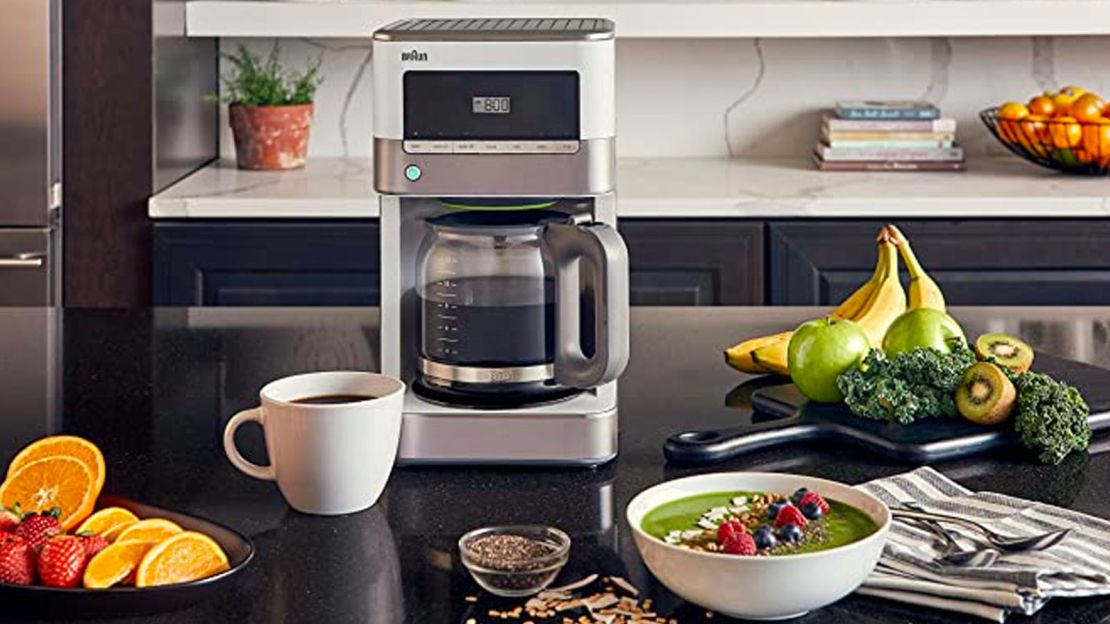
We brewed countless pots of coffee with the BrewSense, ranging from light to dark roast, and each one yielded a strong, delicious cup with no sediment, thanks to the gold tone filter, designed to remove the bitterness from coffee as well reduce single-use paper-filter waste. The machine we tested was white — a nice option for those with a more modern kitchen design — but it also comes in black, and it’s compact enough to fit under the cabinets in a smaller space compared to some of the more cumbersome machines we tested.
The BrewSense is straightforward to operate: It’s designed like a traditional automatic drip machine with manual operating buttons, but with a sleek, modern upgrade. The hardware is a sophisticated combination of brushed metal and plastic, with a glass carafe that feels comfortable in the hand.
The BrewSense doesn’t have a lot of bells and whistles compared to some of the machines we tested, and that functional ease helped elevate it to the top of our list. You could unbox this machine, flush it through with water once, and be drinking a freshly brewed cup within 15 minutes, all without reading the manual. Brewing is also a nearly silent process, which can be pleasing on early mornings. Some consumers may want a machine loaded with special features, but for those who just want delicious, hot coffee every morning, without spending over a hundred bucks, this is your best bet.
The BrewSense isn’t perfect: It’s not the fastest we tested — to brew a full pot of 12 cups took upwards of 11 minutes. And we found an annoying error in the instruction manual around how to program the clock (call us rigid, but we insisted on programming the time before using each of the machines!); the directions read to press and hold CLOCK and then SET, but that didn’t work. We had to simply press and hold the CLOCK button and then sort of trial and error our way through the hours and minutes. Meanwhile, the auto-program setup is not as obvious as we’d have liked; though once we got it, it worked like a dream. But otherwise, we found this machine intuitive and easy to operate even without the instruction manual.
Cleanup could at times be a little messier than some of our other machines. The hot water comes up through the filter basket and spreads the grounds up to the top of the cone, and during one brewing, a tiny bit rose up outside the cone so the top of the brew apparatus needed a little wipedown. Overall, though, for less than $80, this machine delivers the best bang for your buck of anything on the market.
Runner-Up: Cuisinart Touchscreen 14-Cup Programmable Coffeemaker
$130 at Cuisinart and Walmart; From $130 at Amazon
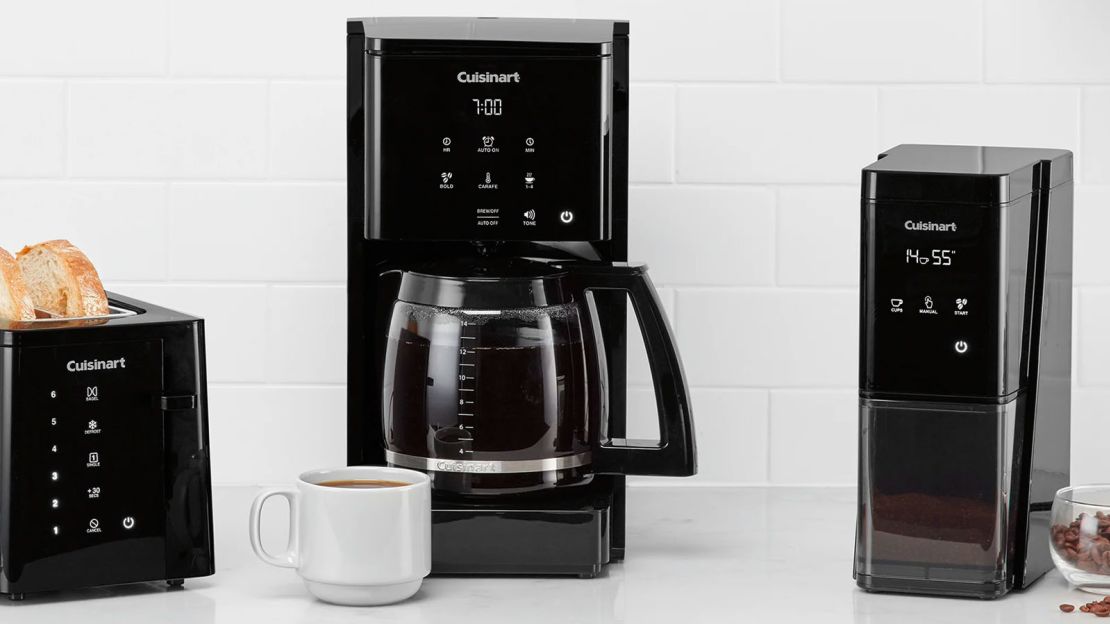
Coming in just a few points behind the Braun BrewSense was one of the three Cuisinart automatic drip machines we tested: the Touchscreen 14-Cup Programmable.
We rated all three Cuisinarts highly, but the Touchscreen ranked highest for its combination of progressive design and everyday efficacy. All the Cuisinart products we encountered were well designed, but this one feels special, like when you unbox a brand-new Apple product: Its all-black, shiny surfaces and touchscreen control panel look and feel next-level for an everyday coffee maker (and the price, $235 at Macy’s, more than three times that of the Braun, reflects that).
But this isn’t just a fancy, aesthetically pleasing machine: It brewed strong, delicious coffee that tasted cleanly filtered but rich. It’s also relatively easy to program and use, given its tech-centric platform. The touchscreen panel features cute little icons signifying one-touch commands to help customize your brew: If you like your coffee bolder, you can select the BOLD feature; if you’re brewing less than half a pot, select the 1 to 4 cups feature for a slower brew with the proper extraction time; adjust the hot plate temperature to low, medium or high; turn the audible brew-cycle-finished tone on or off.
That tech-centric design is also one of the reasons this didn’t come in at number one, however. As exciting and different as it felt, we did feel that this machine — the only touchscreen model we tested — would feel less intuitive and more laborious than some consumers would want as part of their morning coffee routine. The touchscreen goes dark during the brew process, which yes, is nice-looking, but also feels a bit jarring, like you’re literally in the dark, asking yourself, “What’s going on? Is coffee brewing?” The settings and operating buttons are clear enough when illuminated, but it did take us a few times brewing to get used to how much pressure you need to apply with your fingertip to the touchscreen. We could easily think of people in our own lives who would be flummoxed by this machine if left alone with it and a bag of coffee — and for that, it lost a few points in functionality.
Also, like its Cuisinart cousins we tested, this one’s a slower brewer. We clocked 11 minutes for eight cups, and if you’re watching your coffee maker brew like, well, a watched pot, it seems like it … takes forever. We understand the appeal of a slower brewing process (pour-over and Chemex fans, we hear you!), but 12 to 14 minutes for a full pot of coffee seems like a long time to wait when you’re thirsty for your morning Joe and you’re not doing it by hand. Finally, not everyone will want to spend more than $200 on a coffee maker. But many may.
While some consumers might be flummoxed by the technology of this higher-end product, others will embrace it and make it a centerpiece of their kitchen, and rightly so. Form plus function equals morning happiness here.
Best luxury drip coffee maker: Technivorm Moccamaster KBGV Select 10-Cup Coffee Maker
From $345 at Amazon
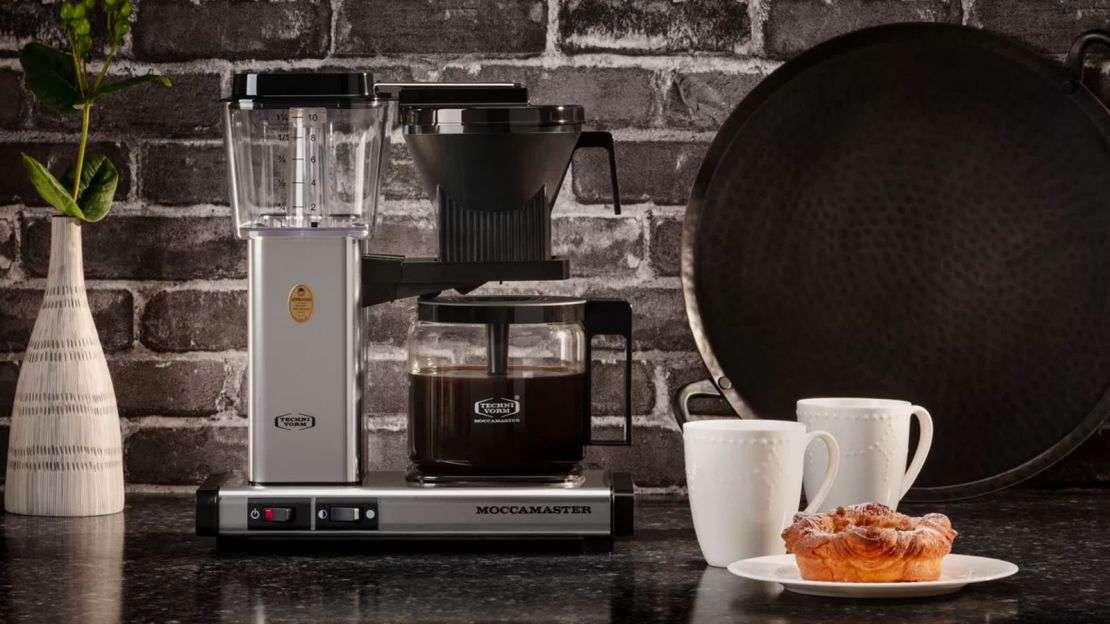
The Technivorm Moccamaster KBGV Select 10-Cup Coffee Maker is an update to our prior luxury favorite, the Moccamaster KBG, Technivorm machines have long had a vocal fanbase and after several weeks of testing, we get the fuss.
The streamlined machine, handmade in the Netherlands since 1968, is a thoughtful mix of industrial and modern design which will appeal to coffee fanatics and design enthusiasts alike. It comes in a host of eye-popping colors, not unlike the KitchenAid stand mixers, ranging from pink (the model we tested) to a bright orange that will wake up before you even take your first sip of coffee.
And the machine is a joy to watch in action. Once you turn on the machine, the brewing starts immediately. Then, seeing the water heat in the tank and bubble up through the water transfer tube into the brewer was a throwback to middle-school science experiments in the most pleasing way, like if a lava lamp produced fresh hot coffee after a few mesmerizing undulations.
And after all that the Moccamaster produces superior drip coffee — it’s not just popular for its looks. Any setting gets you bright coffee with a great aroma. The coffee was best when drunk fresh; but a second cup after an hour still retained a lot of the subtle notes in lighter roasts.
The KBGV is a new and improved model of the Moccamaster KBG, our previous luxury recommendation, differing from the earlier model in that it offers an option for brewing a half-carafe in addition to the full carafe, making it more useful for use through the day, or by single coffee drinkers. It’s a small perk (pun intended) that ups the price of the Moccamster by roughly $20 to $30 (depending on your color choice); but one that is nice if you’re not looking to make 10 cups all the time.
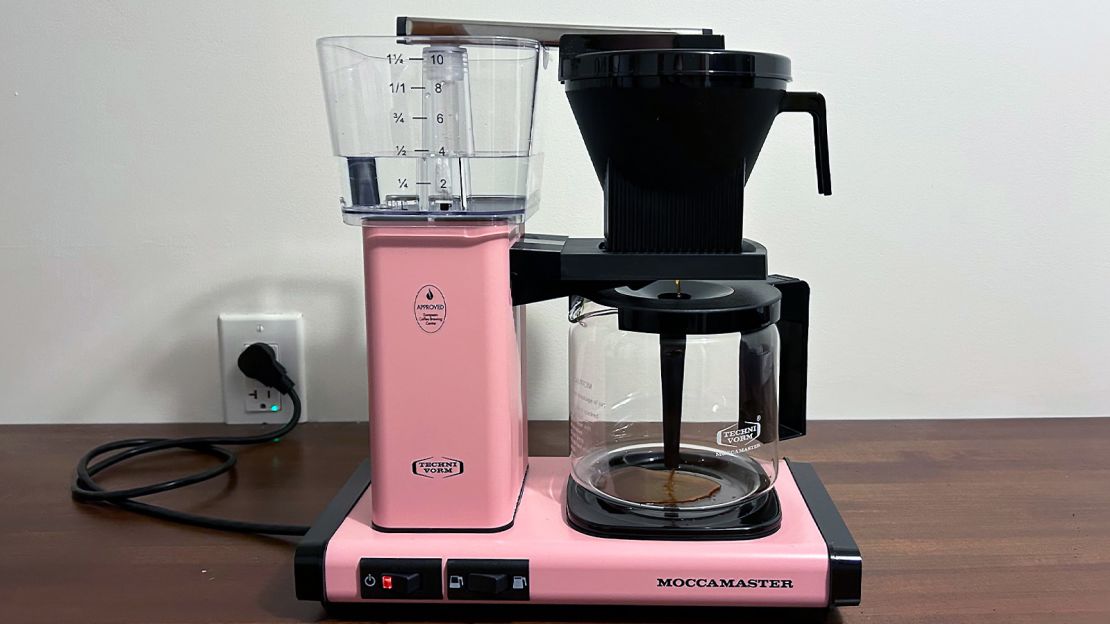
The Moccamaster does require a bit of effort to use, when compared to simpler drip coffee machines. As with all of these devices you’ll have to add the grounds and a paper filter (a No. 4 in this case), but as with the KBG model, you’ll need to take some care as you remove the basket so you don’t dislodge the outlet arm and reservoir lid. Basically you’ll end up disassembling and reassembling the filter basket each time you want to make coffee. It’s less than 30 seconds of effort, which even your non-caffeinated brain can likely handle, and you’ll quickly get used to it, but it’s a little more time and thought than you’ll have to put in with more traditional designs.
While it doesn’t have a timer, the Moccamaster is blazing fast at brewing: it can brew a full carafe in 6 minutes (or up to 6 cups in roughly 4 minutes) and will pause brewing if you need to grab a cup before the coffee is done. The hot plate is programmed to stay on for 100 minutes after brewing is finished and the glass carafe holds heat well.
The Moccamaster is expensive (though a five-year warranty eases the sting). But the bottom line is that its superior coffee further justifies the higher price and the rainbow of colors makes this a coffee machine that stands out.
Best affordable drip coffee maker: Mr. Coffee 12-Cup Coffee Maker
$28 at Target
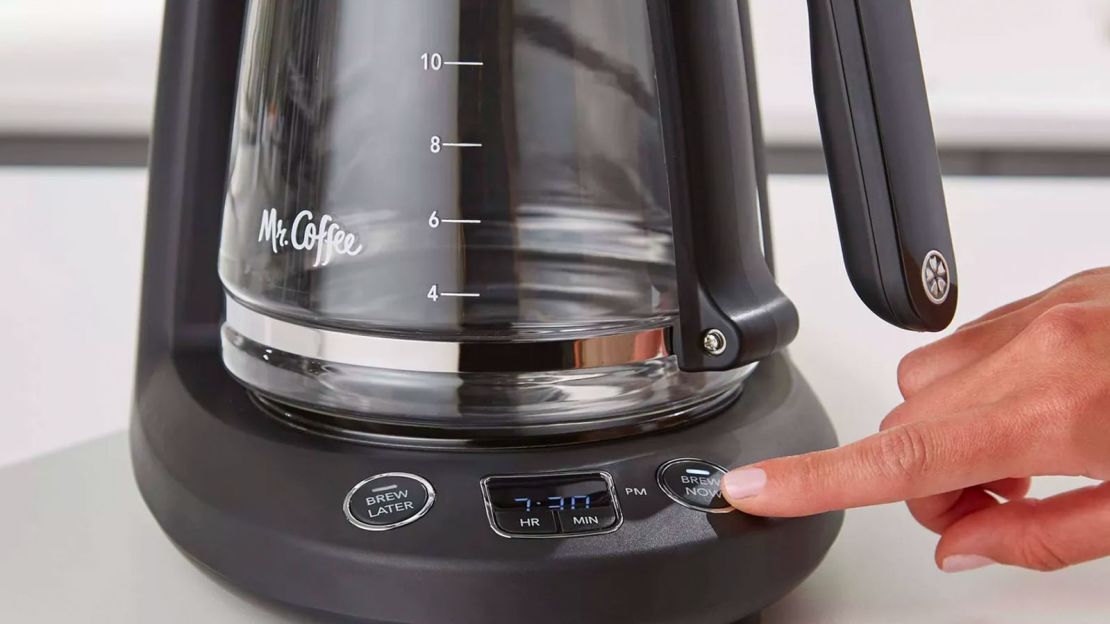
We won’t go on and on about the Mr. Coffee 12-Cup, but it brewed a very workable 12 cups, in both taste and temperature, in just nine minutes. The machine came packaged in some pretty intense plastic and cardboard — the unboxing took a full five minutes and a pair of scissors — but once separated from its packaging, this machine’s a breeze to put together. The hardware is very easy to use (and to program to brew at a specific time), even without reading the directions. It’s compact — one of the best small drip coffee makers we tested — and durable, and the lid, brew basket, carafe and removable top half are all dishwasher safe, which wasn’t common among the machines we tested.
Best drip coffee maker for pour-over coffee lovers: Ratio Six Coffee Maker
$339 $285 at Amazon
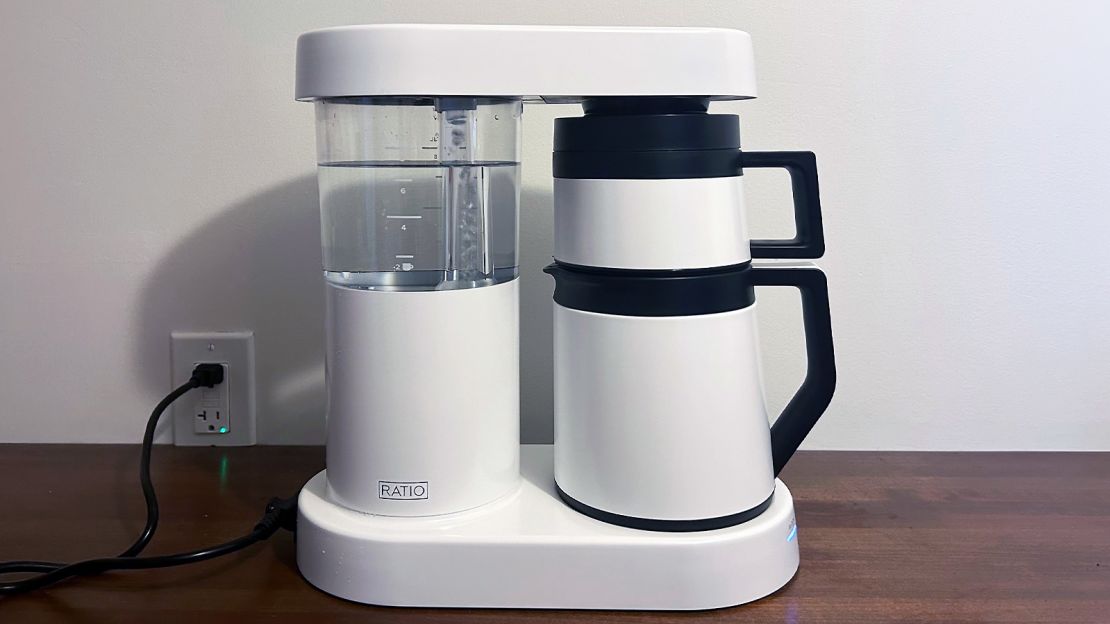
The Ratio Six Coffee Maker is a sleek brewer that automates the pour over coffee process. It works more like a traditional drip coffee maker (and does more of the work for you) than the Balmuda Brew pour over machine — and most importantly, it can brew a whole carafe rather than a single cup at a time, meaning you can serve your whole family or all of your guests at once..
With practice, you can produce a single glorious cup of pour-over coffee by hand, but the Ratio Six lets you get great results immediately by dialing in the water temperature and rate of your pour, which otherwise you’d have to monitor yourself (and learn to do so by trial and error). If you’re early on in your pour over coffee journey the Ratio Six very likely does a better job than you can, producing a satisfying, rounded cup of coffee right away.
The Ratio Six doesn’t have a timer; but a full pot was ready in under 8 minutes. And the simplicity of the design – you hit the button at the base to start or pause the operation – means you’ll quickly know what to do once you’ve unboxed the machine.
Touch the button at the base to start and the Ratio Six has two automatic modes: bloom and brew. The bloom cycle showers down hot water to wet the grounds with a brief pause built in (about 30 seconds) to let the grounds soak up the water. This stage is akin to opening a bottle of wine to let it breathe as the aromas and flavor of the coffee start to be released.
The Ratio Six feels sturdy; but it’s only 8 pounds, so it’s easy to take and off the counter. It’s got a flat bottom filter basket, which helps with water evenly soaking the grounds, that fits a No. 4 paper filter. A heat shield goes on top of the basket and around the brew head to help retain heat.
During the brew cycle, you can see the boiler bubble and water release evenly into the filter basket to run through the pre-soaked grounds. You can pause the brewing cycle – to grab a cup – by removing the carafe or holding the start button for a few seconds. After the ready button blinks, wait about 30 seconds for the final drips to enter the coffee pot.
The carafe held coffee hot for several hours although coffee did occasionally spill out of the side of the spout if the angle was too steep. The large opening of the carafe made it easy to rinse and towel dry.
The Ratio Six has a high price tag; but a five-year warranty should make you feel better about the investment. The modern machine makes 40 ounces of coffee (8 cups) and comes in matte black, matte stainless, or white.
Best drip coffee maker for iced coffee: Zojirushi Dome Brew Coffee Maker
$150 From $108 at Amazon
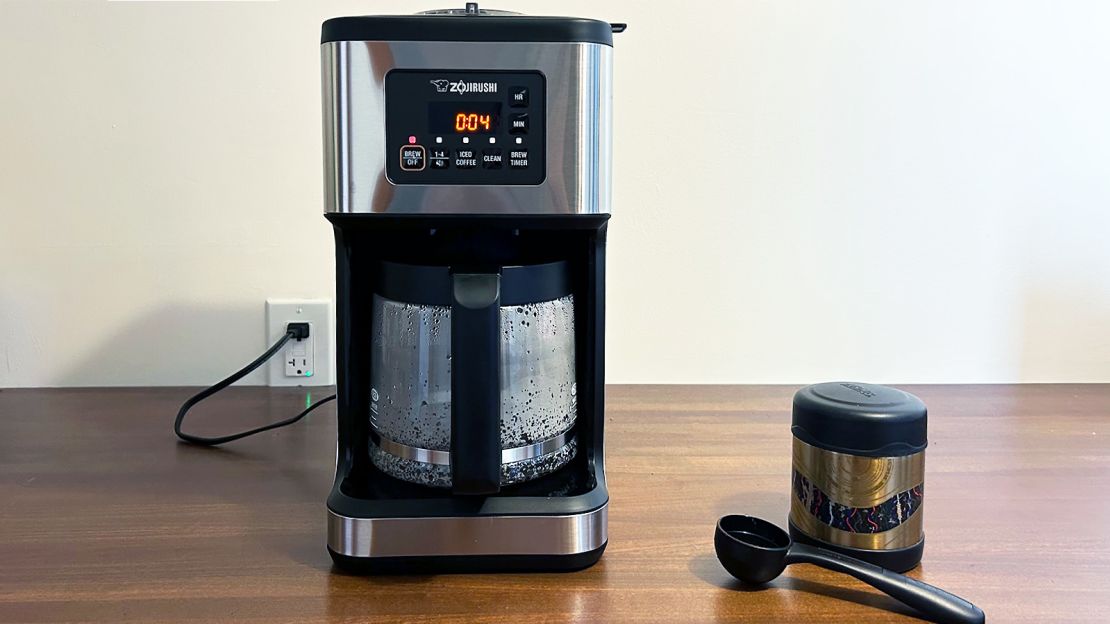
The Zojirushi Dome Brew Coffee Maker requires a bit of patience as a 12 cup carafe will take nearly 15 minutes to brew — one of the slowest machines we tested. But your patience will be rewarded with strong hot brews and delicate iced coffee.
The squared-off, stainless steel machine can be programmed to run up to 24 hours in advance (you can’t set a schedule; you’ll need to set the brew time for first thing in the morning when you load up the machine before you go to bed), which helps because this is a coffee maker that brews significantly slower than the competition. With a dedicated iced coffee setting and button for 1 to 4 cups, you can produce coffee in varying amounts and strengths. Smaller batches benefit from the ‘bold’ setting, where a slide adjusts how quickly the water is released through the shower head onto the grounds below.
The glass carafe has a wide, sturdy handle and slides under a silicone sheath which helps trap heat and makes sure you’re pouring a warm cup. The carafe has distinct markings for iced and hot coffee to keep your measurements straight. The Zojirushi uses No. 4 paper cone filters; but those are inexpensive and widely available.
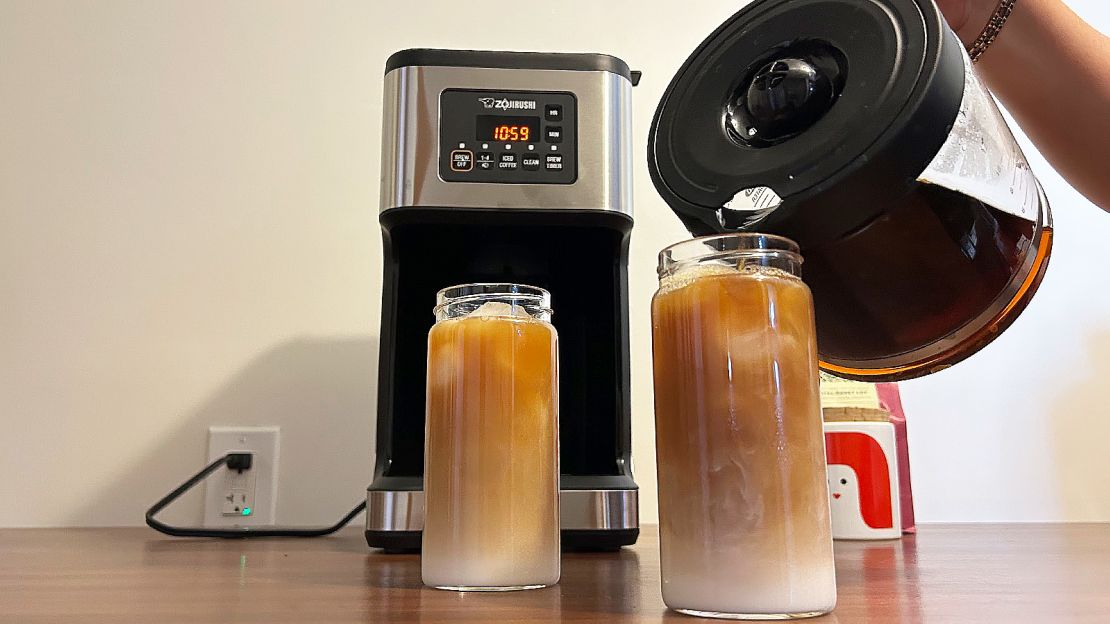
The iced coffee setting, which turns off the heating plate, is noteworthy. It produced iced coffee that accentuated stone fruit notes in light roast coffee without being weak or bitter. The manufacturer recommends 24 ice cubes for six cups of iced coffee (the minimum brew size); but we had better results using two-thirds of their suggested amount, which avoided too much dilution of the flash brew. You can always add more ice to the glass.
The cord is short, so you’ll want to have an outlet close to where you’ll put your coffee maker. If you don’t need a timer, a classic option is available for about $40 less — but we think the long brew time makes it worth investing in the programmable machine that gets started as you’re waking up.
Best smart coffee maker: Café Specialty Grind and Brew Coffee Maker
$329 at Amazon

The Café Specialty Grind and Brew Coffee Maker, a new model from GE’s high-end appliance line, has a striking design that looks like it belongs at the center of your coffee bar, and it backs that up with a bold, bright brew. It’s also the rare smart appliance that actually benefits from app control. The gleaming machine takes care of everything but buying the beans, with a built-in burr grinder and options for adjusting the temperature, brew strength and batch size from a cup on up to a pot.
The brewer can brew either a full pot (it comes with a thermal carafe that holds up to 10 cups) or can brew a single cup or travel mug from 6 to 24 ounces. Both options produced bright, hot coffee without bitterness. The heavy-duty thermal carafe kept our coffee warm for two hours and a handy timer tells you how many minutes ago the coffee was brewed.
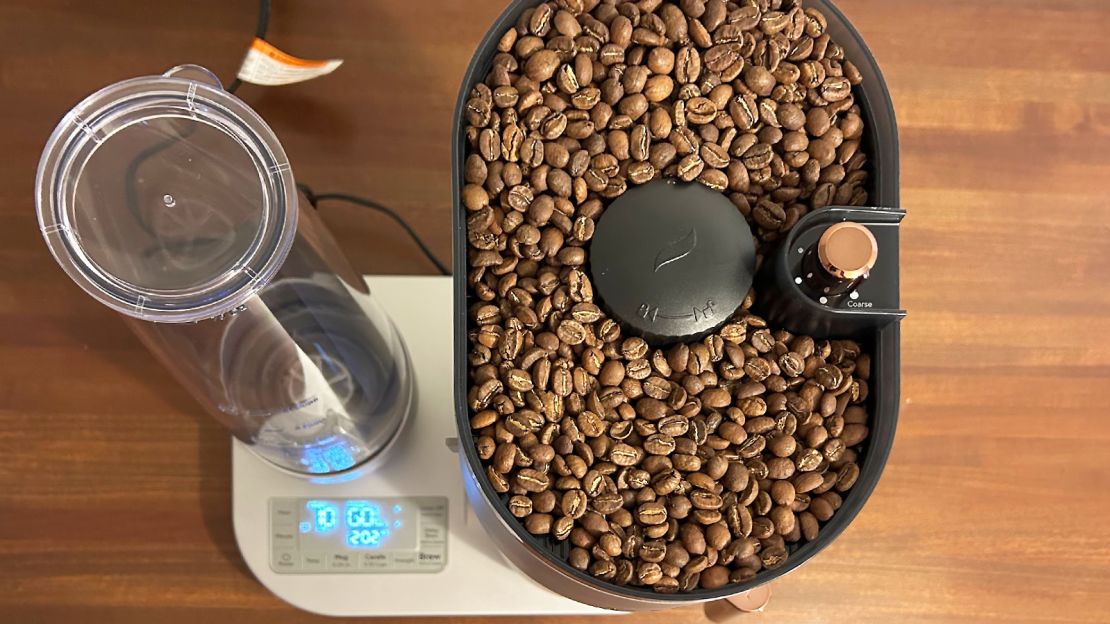
The built-in coffee grinder holds roughly 6 ounces of beans (the manufacturer says its total capacity is 7 ounces or 200 grams), and provides six settings. You can also skip the grinder and add pre-ground coffee. The grinder was effective, giving us good results as we’d expect from a grinder meant to work as part of a system like this, and reasonably quiet.
The Café Specialty Grind and Brew Coffee Maker can sync to your smart device via the Smart HQ app; it can also be set up to respond to Alexa or Google voice controls. The app lets you adjust the brew strength (light, medium or bold) and temperature (between 185 and 205 degrees Fahrenheit), add on bloom time and select the number of cups you’ll brew. Once you’ve got your coffee dialed in using these parameters (strength, temperature and amount of coffee), you can save everything for later use — the machine lets you save three different favorite presets. You can even fill the Café Specialty with beans and water and program the app to prepare coffee up to a week ahead of time (if you’re making a cup for yourself in the morning it’ll have it ready for you every day — though you still have to wash the filter and empty the grounds, so you’re not quite living in the future yet). The machine can also remind you when to reorder a new charcoal filter for the water and if it needs to be descaled. The app is easy to operate, and also really useful.
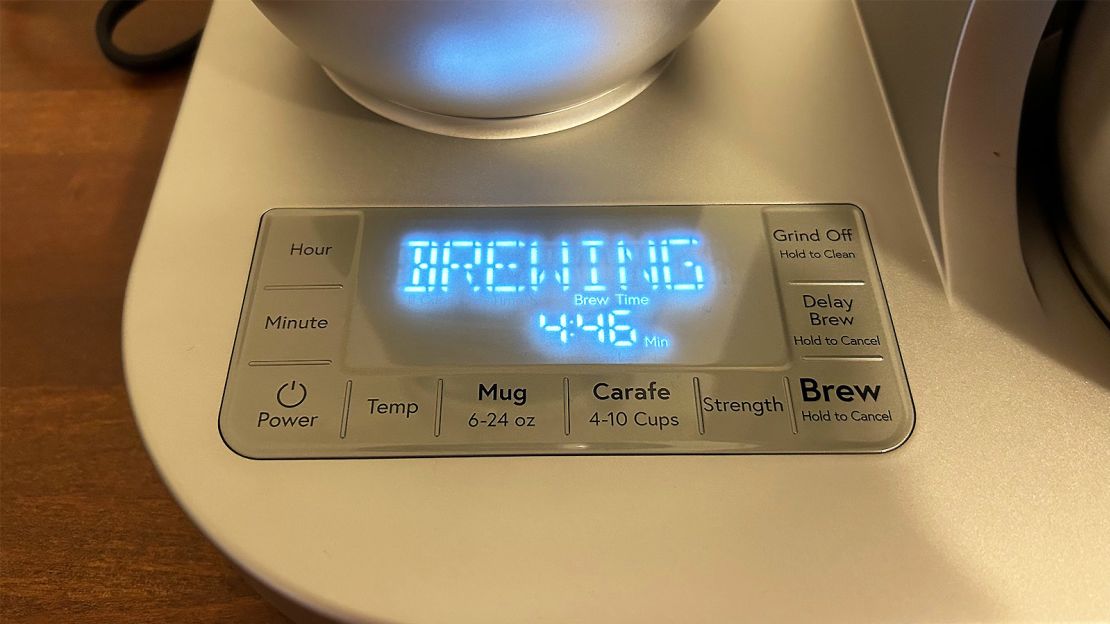
There are a few minor downsides. The menu interface on the machine itself is a bit less impressive than the app. There are a lot of buttons that let you access the features, and manually cycling through the options to get to what you want isn’t difficult, but we felt there was a lot of button-pushing compared to the app. If you’re someone who wants to regularly adjust the temperature or strength to account for different beans, you might find yourself relying on your phone rather than the onboard interface.
We also found that the grinder was a little messy to use — each time we used it, a small amount of coffee grounds became trapped between the grinder and the top of the filter basket. We found it somewhat irritating to wipe it clean after each use, a small additional — but necessary — step beyond rinsing the included reusable filter (which is also dishwasher-safe).
The wide array of features comes with a higher price tag, but the machine only has a one-year limited warranty. It also has a big footprint and takes up a lot of space, roughly the size of a superautomatic espresso machine like the Philips 3200 LatteGo. At nearly 17 inches tall, this coffee machine will not fit under every cabinet and is more suited to sitting on an island or on a coffee bar than a small galley kitchen.
Still, we found the Café Speciality got the important things right, and smart appliance fans will enjoy a hot, strong brew that is only a few taps of your phone away.
How we tested
The testing process for these coffee makers was intensive, lasting more than a month. We evaluated each machine based on what would be most important to the user — namely, functionality, durability and design. We tested each machine at least twice (but four to eight times for some) with both dark and light roast freshly ground beans, did a programmed/timed brew when available, and tested the additional functions of the more specialty machines (single-cup, cold brew, tea, milk frothing). We jotted notes about every machine’s unboxing, read every instruction manual, handled and rehandled the hardware, timed the brew of each machine, noted the temperature of the resulting coffee, and tasted and had others taste and weigh in on user experience. We tried to get as acquainted as possible with each of these machines, became fond of a good many of them — and as a result, we drank way too much coffee over the month in question.
Read on for the categories and their breakdowns.
Brew function
- Optimal temperature: We didn’t take the actual temperature of the coffee from each machine, because we don’t think that’s how the average coffee drinker evaluates home brewing — experts recommend that coffee be brewed at between 195 and 205 degrees Fahrenheit, and served immediately, at 180 to 185 degrees — but we scored the perceived temp of each brew against all the others. We tasted each cup immediately after brewing, black, and then with added cold milk, and recorded the results.
- Taste: The taste of coffee is, obviously, subjective. Two people could spend a lifetime tasting the different coffee varietals and never agree on one. That being said, we tested each machine with both a dark roast and a light roast, keeping the amount of grounds consistent to the machine’s directions. As a result, some machines that recommended using more grounds yielded stronger brews — in those instances, we retested those with less grounds accordingly.
- Time to brew: For each carafe brewed, we timed the process on an iPhone timer, both for a full carafe and half. For those machines that made single cups, we timed that process as well.
- Heat retention: We noted whether the machine brewed into a glass or a thermal carafe, and how hot the coffee remained a half hour to an hour after brewing.
- User-friendliness: We did an initial scan of each machine, evaluating whether a new customer would be able to brew coffee without reading the instruction manual. We then assessed whether the design of each machine is immediately intuitive, and on a more micro level, assessed the settings and buttons on the face of the machine, the markings on the water tank and carafe, how easy the carafe is to fill, and the design of the brew basket.
- Volume yield: We noted how many ounces each machine can brew.
- Programmability: We recorded whether you can program the machine to brew at a set time.
Durability
- Everyday durability: For this category, we assessed how the machine responded to being handled during setup, filling the water tank, adding the grounds, removing and replacing carafe to serve, cleanup, and how durable the hardware felt.
- Build quality: We noted what materials the machine is built from, e.g., plastic, metal, brushed metal, glass, and the tangible feel of each machine in a user’s hands.
- Serviceability: We noted the ease of opening and taking apart the removable parts of each machine, in the case it would need to be serviced.
Setup and breakdown
- Ease of assembly: We observed how long it took to unbox the machine, put it together, and do an initial water flush before the product could be used.
- Size of machine: We assessed how much counter space each machine took up, and how easy it is to move and store.
- Ease of clean: After each brewing, we took note of how easy it was to clean the brew basket, the carafe, and the surrounding hardware.
Aesthetic
- First impression: We observed our first impression of each machine, noting details of design, color, size, feel — whether this machine looked attractive on our counter.
- Color options: We researched if the machine came in any colors besides black.
Warranty
- We checked the number of years of warranty of each machine.
Other drip coffee makers we tested
Krups Simply Brew Coffee Maker
$60 $53 at Amazon
The Krups Simply Brew Coffee Maker is aptly named as once you turn on the power, the petite 10-cup coffee maker gets brewing.
The small profile makes this the kind of lightweight coffee machine you could tuck into a drawer when you’re not using it. But it’s priced slightly higher than comparable machines and doesn’t offer any features other than a permanent filter (you can also use No. 4 paper filters).
The lid of the carafe is fine for pouring, but gets in the way if you’re using the carafe to fill the water tank. Coffee brews quickly – a whole pot is ready in under 10 minutes – but the brew was a bit thin. The Krups get points for allowing you to sneak a cup mid-brew without dripping onto the hot plate below. The hot plate runs for 60 minutes and the thin glass carafe did a surprisingly good job of holding heat.
Oxo Brew 9-Cup Coffee Maker
$230 at Amazon
The Oxo Brew 9-Cup Coffee Maker has the slim profile of a single serving coffee machine with the ability to make enough for a cup and a refill for your brunch crowd. The Oxo brewed strong, hot coffee in larger batches (5 to 9 cups); but the results were less consistent with smaller batches (2 cups is the smallest pot you can make). One four cup pot was thin while another had the right depth. The design is similar to the Ratio Six; but the coffee wasn’t at the same level as the other machine.
The Oxo is convenient. You can program it to brew coffee for your morning or remove the carafe in the midst of the brew cycle to pour yourself a cup. The carafe did an effective job of keeping coffee warm for 60 minutes. The machine shuts off the hot plate after an hour.
The carafe and lid do have to be hand-washed; but the internal parts (the brew basket, showerhead, and silicone mixing tube) can all be cleaned on the top shelf of the dishwasher. After brewing there’s condensation in the brew chamber and water tank, so you’ll have to flip the top open on one and come back later in the day to let the other side air dry. It’s a bit more effort than we wanted to keep the machine clean, although you could speed the process up with a quick wipe of a soft towel.
The control knob took a minute to figure out; but it was easy to switch between choices once the clock was set. The Oxo is a subdued mix of black and stainless steel, well-suited to brewing bigger batches of coffee that let you sneak a cup if you really need it.
Smeg Drip Coffee Maker
$230 at Williams-Sonoma
The Smeg Drip Coffee Maker is like a gleaming Easter egg, a rounded coffee machine that sticks out in a crowd of boxy, stainless steel competitors. The reusable filter is easy to clean, the glass carafe is a slick reincarnation of a diner coffee pot and the 60-minute warmer feature is effective at keeping coffee hot for the full hour.
The Smeg is easy to learn; but the controls are clunky. The toggle on the side to set the clock felt like a carnival game too difficult to win. The water tank, while tucked in back, has a slightly narrow opening making it likely you’ll splash a bit of water onto the grounds. The water line set against a gray background can be difficult to read in early morning sunlight.
The coffee was robust and hot and the option to make a half carafe of four cups was effective. This is a handsome coffee machine – one meant to be displayed – but enough steam releases out of the top of the machine that you wouldn’t want to store this under a cabinet.
Ninja Hot and Cold Brewed System
From $130 at Amazon
We tested two Ninja machines, both of which have some very appealing features. The hot and cold brew system brewed an excellent pot of hot coffee in less than five minutes, as well as a very tasty single cup (in multiple sizes), a less easy feat to perfect. It also brews coffee intended to be served directly over ice, an option that lots of consumers will like. We love the cool, minimalist glass carafe, though the lid features a big hole in the middle for pouring, which can lead to some splashing.
This machine, though prolific in function, lost points because the water tank — plastic with prominent ridges — feels cheap and devolves the user experience a bit (with this machine, thankfully, the plastic tank is in the back, hidden from view, but does need to be handled every time you add water). Another problem with this machine: The water tank doesn’t have marking measurements, only half carafe, and full carafe, and two sizes of single cup. Without ounce or cup markings, how does one know how much water to add versus amount of coffee grounds? The Ninja machines come with a special-sized coffee scoop, different amounts on each end of the scoop, but it was bothersome that the water and the coffee amounts couldn’t be more standardized without relying only on the provided removable accessories (which, for the record, are cute — there’s a removable frothing wand). A lot of performance features with this machine also means a busy control panel that also feels a bit high-maintenance.
Ninja Specialty Coffee Maker with Glass Carafe
$170 $104 at Amazon
The Ninja Specialty is similar to the hot and cold brewed one, with one major difference: The water tank is adjacent to the brew basket, and visible to the eye. This one also brews a very nice cup of hot fresh coffee, and has nifty added functions, too, like myriad sizes of individual cups, half and full carafes, and an over-ice option. The placement of the water tank front and center here, though, makes this one less appealing than the hot and cold option; the tank, similarly, feels flimsy and cheap, a factor that’s difficult to overlook in user experience. For those who like the Ninja brand products (they make blenders and other items), though, there’s a lot of function for your buck here.
Cuisinart PerfecTemp 14-Cup Programmable Coffeemaker
$100 $70 at Amazon
The most basic of the Cuisinart options we tested, this one brewed a nearly perfect cup at, for this reviewer, a perfectly hot temp (even after adding significant cold milk, we still had a steaming hot cup), thanks to an adjustable carafe temp. This machine is solid and well-designed, with one downside (for us): Brewing time was 14 minutes for eight cups, nearly double the time of some of the other brewers we tested.
Cuisinart Coffee Center 10-Cup Thermal Coffee Maker and Single Serve Brewer
$230 $175 at Amazon
Our third Cuisinart brews only 10 cups into a thermal carafe, but has the handy bonus feature of a single-serve brew — with an attachment to use prepackaged coffee pods, or an adorable mini filter to use fresh grounds. (Note: The mini filter is a bit of a chore to clean because it is so small.) Like its Cuisinart siblings above, this machine makes a good brew, but the single-serve coffee maker does make the whole of the hardware more cumbersome. One annoying design issue: There’s an on/off switch on the side of the machine, whose placement feels not intuitive.
DeLonghi True Brew
From $498 at Amazon
The De’Longhi TrueBrew is a superautomatic machine, meaning it incorporates a grinder so you can start with whole beans and have it do the rest for you. At the touch of a button, it can produce a single cup or a whole pot of coffee. The TrueBrew is incredibly convenient, but it’s quite expensive, and despite its wide range of options in our testing we got better tasting coffee from dedicated pour-over coffee and espresso setups. Unless you really want the ease of use of a pod machine along with the ability to use fresh whole beans it may not be for you.
Black+Decker 12-Cup Programmable Coffeemaker, Black, CM1160B
$38 $35 at Amazon
The most affordable automatic drip machine we tested, the Black & Decker 12-cup, is also a solid choice. It brewed eight tasty cups in eight short minutes — overall a good user experience. Hardware-wise, it felt a bit less durable than its closest rival, the Mr. Coffee, but it’s programmable and super easy for near the cost of two lattes with an extra shot.
Bonavita Connoisseur 8-Cup One-Touch Coffee Maker
$190 at Amazon
The Bonavita Connoisseur has its fans, but we had multiple issues with the machine. This pleasingly retro-looking apparatus brews a nice cup quickly and at a good temperature, but the user experience leaves much to be desired. Simply put, the design feels flawed. The lid of the carafe needs to be removed before brewing, so the coffee just brews directly into a wide-open carafe — this was so counterintuitive to us, even after three or four brew tries, that it diminished the experience of the brew process. The brewer also gets very hot during brewing — so hot that we wondered if it might actually be a safety issue. Lastly, after brewing, we screwed the carafe lid back on and tried to return the carafe to underneath the brewer — sure, maybe we were still sleepy, maybe not enough caffeine yet — but the carafe doesn’t fit under the brewer with the lid on; the entire top of the machine popped off. This affects storage of the machine, too; because the carafe lid and the brew basket don’t both fit into the hardware at the same time, there’s always one piece loose.
Breville BDC450 Precision Brewer
$330 at Amazon
We were giddy upon opening this fancy brewer with much to offer: standard brew, fast, gold (what even is that, I wondered at first glance!), cold brew, single cup (with a sold separately attachment), and a customizable to your preferences setting. The options are exciting, but also overwhelming. The user is prompted to enter the consistency of their water, on a hard to soft scale — do all home coffee drinkers know the texture of their tap water? Also, does the average coffee drinker know what Gold Cup certification is? These feel like niche details for an automatic drip machine.
Big picture, the Breville brewed a good pot of coffee, quite quickly, but we didn’t find it hot enough. The whole apparatus is beautifully designed, with sleek brushed metal and a lightweight, handsome carafe lovely enough to join a brunch table. But digging in further, we found this machine just to be… well, just a little too much. Too much hardware — it doesn’t fit easily under our cabinets. Too many options — we needed to read up on a bunch of coffee wisdom before we could even set up the machine to our preferences. There are lots of users who would find this machine the sweet spot of function and sophistication, and enjoy exploring all of its specialties, but for those looking for turnkey coffee-making, this is a little extra.
Balmuda The Brew
$700 at Williams Sonoma
The Balmuda The Brew lets you make pour-over quality coffee in a process as simple as using an ordinary drip coffee machine. A true single-serve coffee maker, Balmuda The Brew occupies a unique spot in the coffee universe. It offers easy — if expensive — access to the world of craft pour-over coffee. It’s really for serious coffee enthusiasts, those who already own a good grinder, maybe already have a great espresso machine and want equally good pour-over coffee from a similarly interesting device. Its ability to make great iced coffee is also a real bonus in warm weather, though you’ll have to decide if it’s worth the price of admission.
